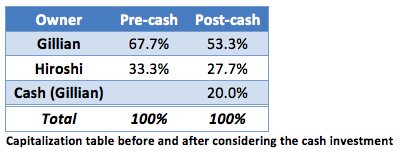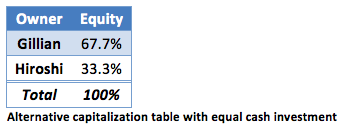Gillian plus Hiroshi
One morning, in the shower, Gillian has a brilliant idea. An idea that will change the world for the better. A potentially billion-dollar idea.
That day, and for the next whole year, she works on a plan to make this idea a reality. Market research, prototypes, and assorted other expenses pile up, totaling $25,000. She happily takes this out of her savings, as she’s convinced this idea is going to succeed.
Eighteen months after that shower, she meets Hiroshi. Hiroshi is the person she’s been waiting to meet. He has twenty years’ experience in the market that her business is aiming at. His contact list is a thousand people long, plus Hiroshi gives numerous talks per year at public events and is known to be a thought leader in this market.
Over drinks after one such event, Gillian confides in Hiroshi, tells him her idea, and asks him to join her in her startup. Hiroshi instantly loves the idea and, after talking it over with his wife, agrees to join in. But… he’s savvy and asks for 40% of the total equity.
At this point, Gillian owns 100% of the company, which she incorporated a few months back. 40% seems like quite a lot to her, given she came up with the idea, put in $25,000 in cash, and recruited Hiroshi to the team. She was thinking that 20% would be fair for Hiroshi.
Gillian and Hiroshi sit down face to face to work this out. They agree that the $25,000 is a significant amount of money and agree that it should be valued at 20% of the total equity. They then agree to compromise at a 2:1 ratio of the remaining shares.
As seen in the table below, the result is that Gillian keeps 73.3% of the total equity (including both herself and her cash), and Hiroshi receives 27.7%.

As described in Rule 9, the cash is considered separately from Gillian’s own sweat equity. This is most easily done by negotiating the equity split without the cash component and then diluting everyone’s ownership by the value of the cash. Hence the two columns in the table above.
Or…
Alternatively, if Hiroshi had the resources and was willing to match Gillian’s cash investment of $25,000, they could simply offset the value of that cash, and stick with the 2:1 ratio (as seen below).

Or…
If Hiroshi was willing to put in some capital but less than Gillian’s $25,000, they could agree that Hiroshi’s cash was worth a fixed proportion of Gillian’s cash.











There’s a little mathematical error in the cap. table. 67.7 should be 66.7 & 27.7 should be 26.7.